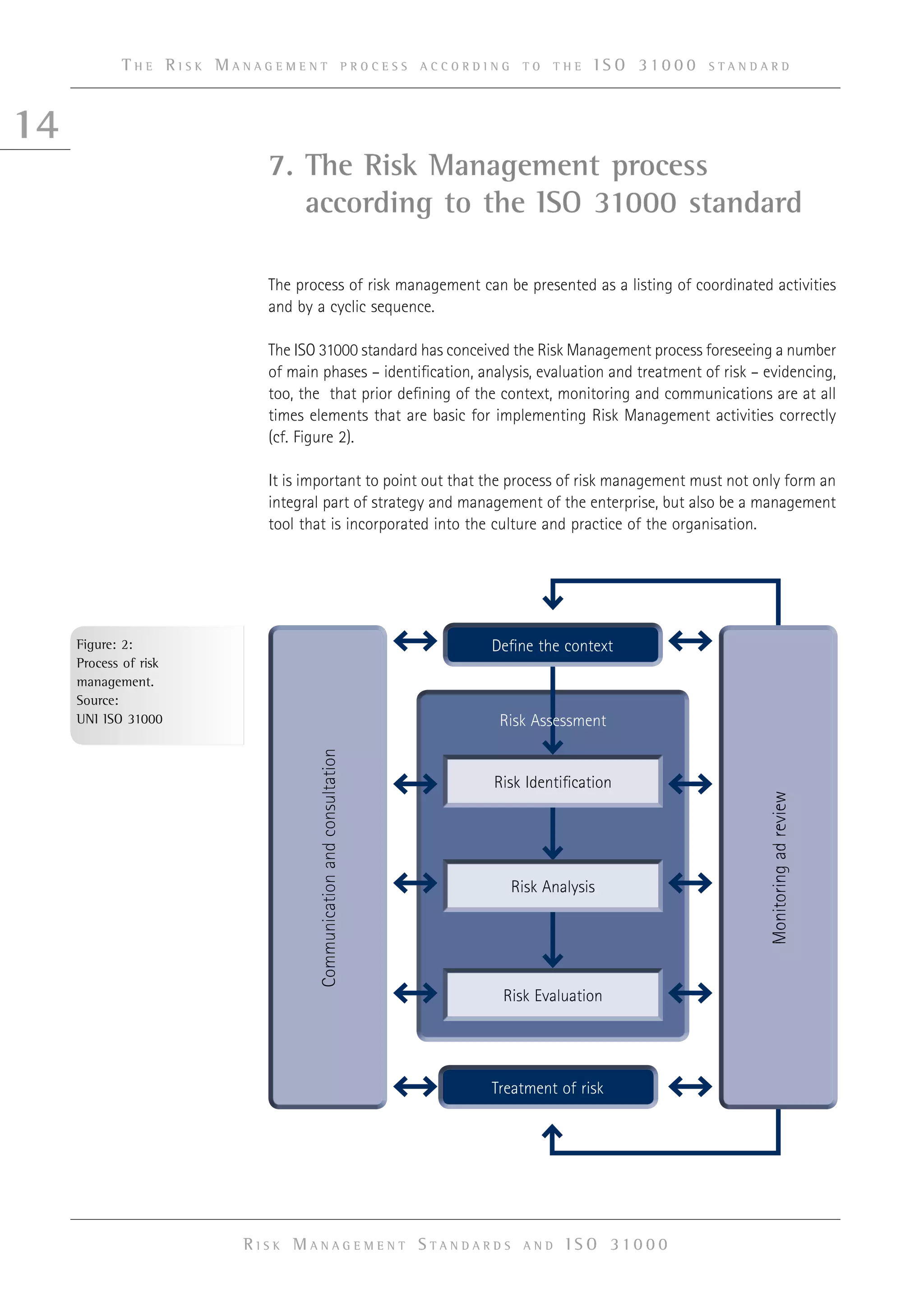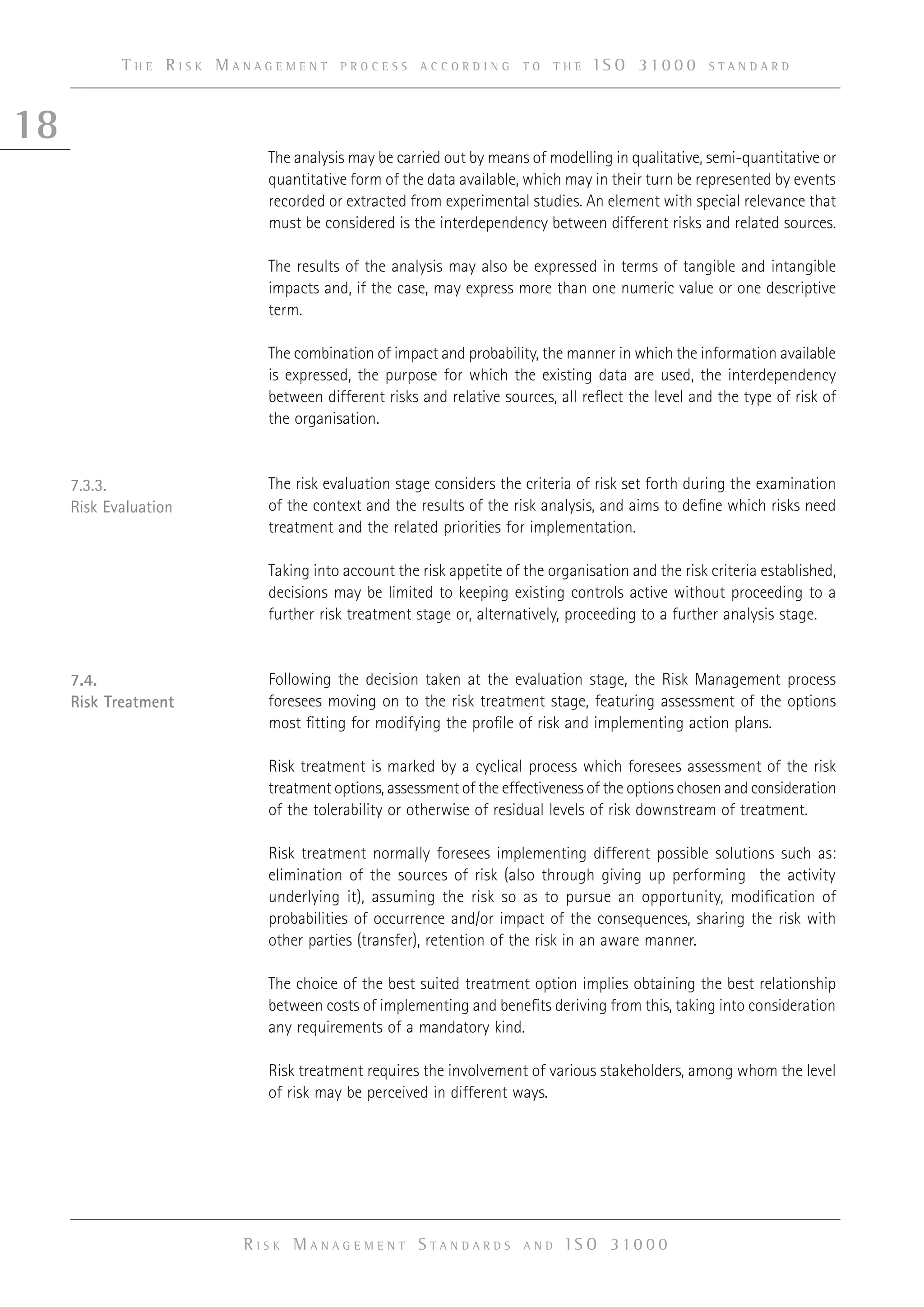1. The document discusses risk management standards and ISO 31000. It aims to promote understanding of ISO 31000, which provides a framework for managing risk based on international best practices.
2. ISO 31000 advocates a structured and consistent approach to risk management throughout an organization to help ensure risks are effectively identified and addressed. It provides principles and guidelines for managing risk from identification through monitoring.
3. Adopting a common risk management standard like ISO 31000 allows organizations to systematically manage increasingly complex and global risks in a transparent, scientifically rigorous manner, improving professionalism and the role of risk managers.








![4
which have ruled in the matter of failure to adopt adequate organisational models in
the terms of Legislative Decree 231/01 and safety measures to protect consumers (e.g.
risk of product recall).
The lawmaker has issued detailed provisions directed towards listed companies aimed
at taking advantage of adequate analyses and management of corporate risks.
The Consolidation Act on Finance which governs the sector foresees, among other
things, the duty for delegated administrative bodies and senior managers who deal with
drawing up corporate accounting documents, to attest by means of a specific report
attached to the financial statements for the accounting period, and the consolidated
one, to having arranged adequate administrative and accounting procedures directed
towards forming the financial statements and all other notices of a financial character.
The management report includes a reliable analysis of trends and the result of management
as well as the situation of the issuer and the companies included in consolidation,
together with a description of the “main risks and uncertainties they are exposed to”6
.
It should be borne in mind moreover that the provisions of the Civil Code in the
matter of financial statements intended for publications relating to the regime of
waivers foreseen under art. 2423 of the Civil Code, sets forth that “If the information
required by specific provisions of the law are not sufficient for giving a truthful and proper
representation, complementary information necessary for the purpose must be given”. It
should be noted that the waiver is not to be understood as being a discretion but rather
a duty foreseen for the purpose of safeguarding the clause in respect of truthful and
proper representation. Whereas Art. 2423-bis of the Civil Code “Principles for drawing
up financial statements” imposes in drawing up financial statements, abidance by the
following principles: assessment of the headings in accordance with prudence and from
a perspective of a going concern; […] 4) and which takes into account risks and losses
concerning the accounting period, even if becoming known after this closes; […].
Consider too, concerning art. 19, paragraph 1, letter b) of Legislative Decree 39/2010, that
in dictating rules in the matter of legal auditing of annual accounts and consolidated
accounts, imposes upon bodies of public interest that the internal control committee and
accounting audit “oversee the effectiveness of the system of internal control, internal
auditing, if applicable, and risk management”.
The general interest and the importance that lawmakers attribute to the Risk Management
function is further demonstrated by the fact that the Ministry of the Economy and
Finance requires specific skills in the matter of “risk management and internal control”
in respect of those who wish to take the examination of professional fitness to earn the
R i s k M a n a g e m e n t S t a n d a r d s a n d I S O 3 1 0 0 0
R e f e r e n c e c o n t e x t
2.1.
Listed companies
6. See art. 154 bis letter e) of Legislative Decree no. 58/1998 as modified in 2005 by law no. 262 to protect savings.](https://image.slidesharecdn.com/riskmanagementiso31000-180216145312/75/Risk-management-ISO-31000-9-2048.jpg)

![6
As long ago as 2008, the national oversight authority for the sector, ISVAP, had introduced
by regulations no. 20/2008 the duty applying to insurance companies of creating
internally a Risk Management function appropriate for the nature, size and complexity
of its activity.
This function responds to the administrative body and its organisational placement
must be such as not to depend on operating functions; in abidance by art. 21 of these
regulations, the function of Risk Management:
a) takes part in defining the methodologies for measuring risks;
b) takes part in defining operating limits assigned to operating structures and defines the
procedures for timely verification of these limits;
c) validates the flows of information necessary for ensuring timely control of exposure
to risks and immediate detection of anomalies found in operations;
d) prepares reporting forms of operating structures towards the administrative body,
senior management and heads of operating structures concerning trends in risks and
breach of the operating limits set;
e) verifies the consistency of models of measurements of risks with the operations
performed by the enterprise;
f) takes part in effecting stress tests.
On the other hand publication of ISVAP regulations no. 39/2011 in respect of compensation
policies of insurance companies is recent and which, in line with international leanings,
must be consistent with healthy and prudent management of risk and in line with
strategic objectives […] (art. 4 regulations 39/2011)10
. The regulations assign to the
Board of Directors the duty of involving the internal control functions (Internal Audit,
Risk Management and Compliance) and Human Resources in defining compensation
policies together with creating mechanism of incentive that take into account, “where
appropriate,alsothe objectivesofa noneconomickind,such as compliance andefficiency
in the management of client services” (art. 12, paragraph 2, letters a and b)11
.
Also the regulatory provisions of the oversight Authority of the insurance sector aim to
implement an efficient system of management involving insurance companies directly via
the requirement to proceed to self-assessment of the capacity of current compensation
systems to meet regulatory provisions12
.
R i s k M a n a g e m e n t S t a n d a r d s a n d I S O 3 1 0 0 0
R e f e r e n c e c o n t e x t
10. SVAP Regulations no. 39/2011 art. 4 General Principles: Enterprises are to adopt compensation polices consistent with
health and prudent management of risk and in line with strategic objectives, profitability and balance of the enterprise
in the long term. 2 Enterprises are to avoid compensation polices based exclusively or prevalently on short term results
such as to create incentives to excessive exposure to risk.
11. Insurance companies are bound to adopt compensation policies that measure the performance of directors on
the basis of indicators that take into account risks associated and correlated charges, within a non brief temporal
horizon […] and that create mechanism of incentives that take into account “where appropriate also of the objectives
of a non economic kind, such as compliance and efficiency in management of client services” (ISVAP Regulations no.
39/2011 art. 12)
12. With effect from 1st
January 2011 the new oversight Authorities of the European financial sectors at a macro and
micro prudential levels are operational; the EIOPA superintends the insurance area.](https://image.slidesharecdn.com/riskmanagementiso31000-180216145312/75/Risk-management-ISO-31000-11-2048.jpg)


















